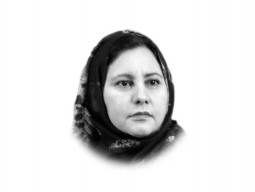
Population in the western part of the Muslim world — the stretch of land between South Asia and northwestern Africa — is very young, with the median age of only 22 years. Of the 900 million people who live in this region — 400 million Arabs and the remaining 500 million non-Arabs — 450 million are below that age. This is the result of high rates of population increase over the last several decades. This, in turn, was because of the high rates of total fertility (TFR), with six to seven children born per woman. There have been declines in TFR in most of the developing world, but not so much in Muslim countries. High growths of population will continue to be a salient demographic feature of the landscape in these countries. Populations in these countries are also highly mobile. They have moved inside the countries, leaving the countryside, and going to large and growing urban centres. Some of these movements are the result of the turmoil created by the rise of extremism. The UN calls these people “internally displaced persons” (IDP). The IDPs are moving into such large cities as Beirut, Cairo, Damascus, Kabul and Karachi, creating centres of present and future turbulence. But there are other types of people’s movements as well. Millions of people have left their countries and moved to those within the region where better work opportunities were available. Some have gone to other continents, creating several large diasporas, some of which have become the sources of supply of fresh recruits to the movements associated with extremism.
The area’s youth form the base around which a large, rapidly growing middle class is being formed. Many in this class are fresh graduates from poverty, helped by the remittances sent by their relatives doing work outside. This expanding middle class has about 500 million people. Some in this economic category have aspirations that are very different from those of the older generations. Some of the members of this economically alert group have been converted to the idea espoused by the leaders of radical groups. To quote from an incisive report published by The Washington Post, a British extremist activist named Anjem Choudhry of Pakistani origin and “other enablers remain free to spread their seductive messianic ideology on the streets of the UK and globally through the internet … [It is hard] to ignore their record of inspiring impressionable young to carry out violence in the name of Islam — both in Britain and overseas.”
But those from among the young and the middle class, who have been converted to the Choudhry-style of radicalism, are relatively small in number compared with those who have different kinds of aspirations. A significant number of these have been alienated from the political and economic systems in which they grew up and in which they have continued to live. Their frustration led to the Arab Spring of 2011 and four years before that to the lawyers movement — the ‘black coats’ campaign — in Pakistan. They also formed the backbones of two recent populist movements that ‘gharoed’ Islamabad for weeks this summer. The aim of these movements was the same: to replace authoritarianism with more representative forms of governance. Drawing on the insights from Albert Hirschman’s book Exit, Voice and Loyalty, it appears that one large segment of the middle class preferred to use the option of “voice” to enter the political and economic structures that had mostly excluded them. The other chose the “exit” route, moving away from the established systems altogether. They preferred, instead, to join the various extremist movements.
The fight against extremism that has now been joined by the West and is led by the US must aim to keep the Muslim youth tied to the systems that are in place, rather than totally abandon them. However, these systems have to be totally transformed. To use the terms popularised by social scientists, Daron Acemoglu and James Robinson in their book Why Nations Fail, these systems have to move from being “exclusive” — only for the privileged few — to being “inclusive” — for most in society. There will have to be simultaneous action on a number of fronts, not just the use of force. This will take a long time, will require patience and will need an entirely different approach by the West towards the Muslim world.
Published in The Express Tribune, October 20th, 2014.
Like Opinion & Editorial on Facebook, follow @ETOpEd on Twitter to receive all updates on all our daily pieces.













COMMENTS
Comments are moderated and generally will be posted if they are on-topic and not abusive.
For more information, please see our Comments FAQ